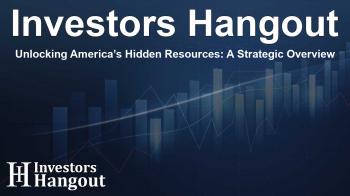Unlocking America’s Hidden Resources: A Strategic Overview

Exploring Untapped U.S. Resources
With growing excitement surrounding President Trump’s ambitious economic legislation, known as the “Big Beautiful Bill,” a significant discussion has emerged regarding an often-overlooked U.S. resource. This policy aims to revitalize American infrastructure and energy and could have far-reaching effects on the nation’s economy.
A Surprising Presentation from a Former CIA Insider
A presentation by Jim Rickards, a former CIA advisor and White House insider, has surfaced at a critical moment, shedding light on a substance-rich area of the United States that has been ignored for years. Rickards highlights that there are abundant minerals buried under federally managed lands that could support large-scale economic initiatives.
Critical Resources Awaiting Utilization
According to Rickards, these untapped resources are essential for the economy, including materials such as copper, uranium, rare earth elements, and lithium. He notes staggering figures that indicate the potential wealth lying dormant:
“$516 billion is available in the Salton Sea region of California, while Nome, Alaska holds $3.1 trillion, and Midland, Texas contains approximately $7.35 trillion in resources,” he elaborates.
Government Inaction and its Consequences
Rickards emphasizes that the inaction of the government has played a significant role in allowing this resource base to flourish. He describes it as a ‘trust,’ allowing resources to remain untouched for years due to political hesitations. This persistent inactivity has facilitated the growth of untapped assets.
A Possible Shift in Policy
Recent statements from President Trump suggest a notable change in federal policy regarding resource management. He has alluded to the potential of using these vast resources, which have previously been hindered by environmental restrictions. “There are great, raw earth resources available, and I intend to open them up,” Trump stated. This could signal a shift towards embracing these valuable materials for economic rejuvenation.
Fast-tracking Resource Recovery
Rickards sees this move as a strategy to accelerate the mining of these resource-rich federal lands. He proposes that this reopening could enable companies to extract trillions of dollars’ worth of materials right here in America, highlighting a potential turning point in federal resource policy.
Economic Impact Without Traditional Stimulus
While Rickards does not claim direct funding for Trump’s sweeping legislative plan, he suggests that the unlocking of these resources could serve as a crucial financial foundation. “This isn’t a traditional government program like those Covid relief checks. Instead, it represents an opportunity for the average American to significantly enhance their financial standing,” he explains.
Clarifying Misconceptions About Resource Allocation
Rickards makes it clear that his proposal is not about distributing funds directly to individuals, but rather about leveraging national resources for broad economic improvement. He shares that his terminology aims to resonate with the public, highlighting the comprehensive benefits of tapping into these hidden resources.
Revisiting Dormant Projects
The presentation also reveals that many infrastructure and resource development projects have languished for years. “Despite having this rich endowment right beneath us, we chose not to engage with it.” As discussions turn to harnessing domestic resources, Rickards posits that these stalled projects may soon receive renewed attention and funding.
Who is Jim Rickards?
Jim Rickards is well-regarded for his extensive background in economic security. Having advised the CIA, U.S. Treasury, and the Pentagon, Rickards played a crucial role in establishing the original Petrodollar Accord. His perspectives on global finance and national resilience have shaped his reputation as an expert in the field, and he is recognized as a bestselling author.
Frequently Asked Questions
What is the “Big Beautiful Bill”?
The “Big Beautiful Bill” refers to President Trump’s comprehensive legislative proposal aimed at revitalizing U.S. energy and infrastructure sectors.
What resources does Jim Rickards discuss in his presentation?
Rickards highlights critical materials such as copper, uranium, rare earth elements, and lithium lying beneath federally managed lands.
How could unlocking these resources benefit Americans?
Utilizing these dormant resources could potentially increase the economic wealth of the country, benefiting the average citizen indirectly.
What shift in policy is suggested regarding U.S. resources?
Recent statements suggest a strategic pivot towards reopening federal lands for resource extraction, previously restricted by environmental policies.
Who is Jim Rickards and what is his background?
Jim Rickards is a former CIA advisor with expertise in economics, authoring several books on economic security and contributing to U.S. financial strategies.
About The Author
Contact Owen Jenkins privately here. Or send an email with ATTN: Owen Jenkins as the subject to contact@investorshangout.com.
About Investors Hangout
Investors Hangout is a leading online stock forum for financial discussion and learning, offering a wide range of free tools and resources. It draws in traders of all levels, who exchange market knowledge, investigate trading tactics, and keep an eye on industry developments in real time. Featuring financial articles, stock message boards, quotes, charts, company profiles, and live news updates. Through cooperative learning and a wealth of informational resources, it helps users from novices creating their first portfolios to experts honing their techniques. Join Investors Hangout today: https://investorshangout.com/
The content of this article is based on factual, publicly available information and does not represent legal, financial, or investment advice. Investors Hangout does not offer financial advice, and the author is not a licensed financial advisor. Consult a qualified advisor before making any financial or investment decisions based on this article. This article should not be considered advice to purchase, sell, or hold any securities or other investments. If any of the material provided here is inaccurate, please contact us for corrections.

